Three books for electricians from beginners to professionals
 It is not always possible to find structured, relevant information. In this regard, in 2019, the publishing house “Science and Technology” (SPB) published 3 books for electricians. "Electrics for the curious." “Modern power grid. Workshop electrician. " Book + video course on DVD. Author - Stern M.I. “Modern power grid. New technical solutions. " Book + video course on DVD. Author - Stern M.I.
It is not always possible to find structured, relevant information. In this regard, in 2019, the publishing house “Science and Technology” (SPB) published 3 books for electricians. "Electrics for the curious." “Modern power grid. Workshop electrician. " Book + video course on DVD. Author - Stern M.I. “Modern power grid. New technical solutions. " Book + video course on DVD. Author - Stern M.I.
The first book, Electrics for the Curious, is aimed at schoolchildren, students, and other people who want to get to know the world of electricity for general development or become an electrician in the future. The book is divided into two main parts - theory and practice. The theoretical part is brief, it includes the basic concepts of electricity and electrical circuits, laws and information about electrical engineering in general, in general, the necessary minimum knowledge for an electrician ...
The most popular electrical devices in electrical installations
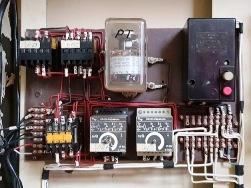 All electrical devices used in production can be divided into 3 groups: control, monitoring and protection devices. The devices of the first group are divided into manual and remote control devices. The second group includes various sensors and relays that perform the functions of sensors. The devices of the third group protect electrical installations from various emergency operating modes (short circuits, current overloads, voltage increase and decrease, etc.).
All electrical devices used in production can be divided into 3 groups: control, monitoring and protection devices. The devices of the first group are divided into manual and remote control devices. The second group includes various sensors and relays that perform the functions of sensors. The devices of the third group protect electrical installations from various emergency operating modes (short circuits, current overloads, voltage increase and decrease, etc.).
The most common electrical devices in electrical installations are electromagnetic starters, electromagnetic relays, control buttons, circuit breakers and thermal relays. These are the most popular electrical appliances. A huge number of them are released all over the world. They are designed for remote control of various power loads, most often electric motors, but are also used to control other powerful consumers ...
Wattmeters - types and application, connection diagram, features of use
 Each consumer, powered by an electric network, consumes some power. Power characterizes in this case the speed of the electrical network performing the work necessary for the operation of a particular device or circuit, which is powered from this network. Of course, the network must be able to provide this power and not be overloaded at the same time, otherwise an accident can occur.
Each consumer, powered by an electric network, consumes some power. Power characterizes in this case the speed of the electrical network performing the work necessary for the operation of a particular device or circuit, which is powered from this network. Of course, the network must be able to provide this power and not be overloaded at the same time, otherwise an accident can occur.
To measure power consumption in alternating current circuits, special devices are used - wattmeters. Wattmeters show the current power consumption, and some of them are even able to calculate the amount of energy in kilowatt hours consumed in a certain time while the consumer was working. In this article, we will consider several main types of power meters. Wattmeters are used in various fields of industry and everyday life, especially in the electric power industry and in mechanical engineering ...
Grounding wire - cross-section, marking, color, connection, requirements for grounding conductors
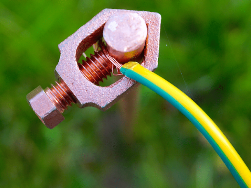 Most electrical installations are always earthed using a special ground wire. The ground wire is designed to connect the conductive elements of the installation to the ground, which initially has zero potential, and thereby create a safe zero potential on the grounding element. The main purpose of the ground wire is to protect a person from electric shock if the phase voltage supplying the unit for some reason gets on its case.
Most electrical installations are always earthed using a special ground wire. The ground wire is designed to connect the conductive elements of the installation to the ground, which initially has zero potential, and thereby create a safe zero potential on the grounding element. The main purpose of the ground wire is to protect a person from electric shock if the phase voltage supplying the unit for some reason gets on its case.
An example is a washing machine, in the wiring of which the insulation is damaged over time and the bare phase wire at some point touches its metal case of a household appliance.In this case, a person is at risk, because if he touches the car’s body, he will get an electric shock, since current will flow through his body in the direction of the earth, but the person is practically on the floor, which is not always securely isolated ...
Voltage, resistance, current and power are the main electrical quantities
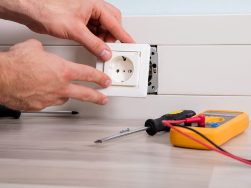 In electrical engineering, it makes no sense to simply say “electricity”. Here it is always necessary to specify what exactly is being discussed. We can mean the electric charge of the capacitor, the voltage in the outlet, the current flowing through the wires, or for example the power that the electric meter in our apartment wound in a month.
In electrical engineering, it makes no sense to simply say “electricity”. Here it is always necessary to specify what exactly is being discussed. We can mean the electric charge of the capacitor, the voltage in the outlet, the current flowing through the wires, or for example the power that the electric meter in our apartment wound in a month.
In any case, there is no such quantity as electricity, there is the quantity “amount of electricity”, correctly called the electric charge, which is measured in pendants. This is an electric charge - it moves along the wires, accumulates on the plates of the capacitor, is periodically present at the terminals (minimum - on the phase wire) of the outlet, moves in the form of current when the electric network performs work. The main electrical quantities are somehow related to the charge. We will talk about these values today. Voltage is measured between two points in a circuit ...
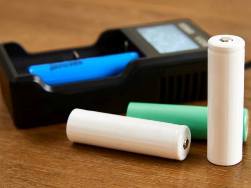 A direct current is a current that almost (since there is nothing perfect in the world) changes in time, neither in magnitude nor in direction. Historically, the first direct current sources were exclusively chemical. At first they were represented only by galvanic cells, and later batteries appeared.
A direct current is a current that almost (since there is nothing perfect in the world) changes in time, neither in magnitude nor in direction. Historically, the first direct current sources were exclusively chemical. At first they were represented only by galvanic cells, and later batteries appeared.
Galvanic cells and batteries have a strictly defined polarity, and the direction of the current in them does not change spontaneously, therefore chemical current sources are fundamentally direct current sources. The AA AA battery is a prime example of a modern galvanic cell. A cylindrical alkaline battery (which they like to call alkaline, while the word alkaline is translated as alkaline) contains a solution of potassium hydroxide as an electrolyte inside. At the positive pole of the battery is manganese dioxide, and at the negative - zinc in the form of a powder ...
How sensors and clamp meters work for measuring direct and alternating current
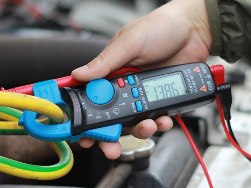 To expand the functionality of multimeters, oscilloscopes and other electrical measuring instruments, clamp-shaped current sensors are used - current clamps. To take measurements with clamps, they are closed into the girth of the conductor with current, and thus, without breaking the circuit and without the need to cut any shunt into the conductor, they measure.
To expand the functionality of multimeters, oscilloscopes and other electrical measuring instruments, clamp-shaped current sensors are used - current clamps. To take measurements with clamps, they are closed into the girth of the conductor with current, and thus, without breaking the circuit and without the need to cut any shunt into the conductor, they measure.
It is simple and convenient. The device displays the measurement result on its scale in the form of voltage or current proportional to the measured current value. The advantage of the method lies in the fact that the device may not have a sufficiently wide input range, while the sensor - clamps are quite able to freely accept the conductor even with a very high current. The conductor with the measured current not only remains intact, but is always galvanically isolated from the circuits of the measuring device. The device itself may have an input circuit with a very high impedance ...
The use of the Wheatstone bridge for measuring non-electric quantities
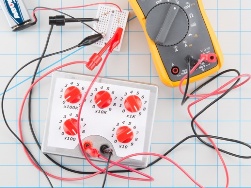 The Wheatstone Bridge is an electrical circuit designed to measure the magnitude of electrical resistance. This scheme was first proposed by British physicist Samuel Christie in 1833, and in 1843 it was improved by inventor Charles Wheatstone. The principle of operation of this scheme is similar to the action of mechanical pharmacy scales, but it is not the forces that are equalized here, but the electric potentials.
The Wheatstone Bridge is an electrical circuit designed to measure the magnitude of electrical resistance. This scheme was first proposed by British physicist Samuel Christie in 1833, and in 1843 it was improved by inventor Charles Wheatstone. The principle of operation of this scheme is similar to the action of mechanical pharmacy scales, but it is not the forces that are equalized here, but the electric potentials.
The Wheatstone bridge circuit contains two branches, the potentials of the middle terminals (D and B) of which are equalized during the measurement process. One of the branches of the bridge includes a resistor Rx, the resistance value of which must be determined. The opposite branch contains a rheostat R2 - adjustable resistance. Between the middle terminals of the branches, the G indicator is on, which can be a galvanometer, a voltmeter, a zero indicator or an ammeter ...
